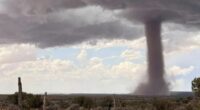Share this @internewscast.com
Just 31 and in good health, Jess Cain was horrified to discover a small lump in her neck, which she had thought little of, was cancer.
A special needs teacher was feeling healthy and symptom-free when her massage therapist noticed a growth and advised her to consult a doctor.
Anticipating a simple check-up, she was instead diagnosed with thyroid cancer and informed she would need swift surgery, followed by several months of treatment.
“My doctor informed me that the tumor likely developed nearly a decade ago,” Jess remembered. “I never experienced pain or any symptoms. I wasn’t aware of thyroid cancer at all. It was such a shock to hear.”
Such diagnoses are becoming more frequent. Thyroid cancer, which impacts the small butterfly-shaped gland in the neck, has surged over the past 20 years. In the UK, cases have increased by 62% in just the past decade and are projected to rise by nearly 75% by 2035.
The thyroid is responsible for producing and releasing hormones that regulate essential functions, including metabolism—how the body utilizes energy—along with heart rate, temperature, and growth.
Thyroid cancer is one of five cancers increasingly affecting younger adults, according to the American Cancer Society, along with throat, prostate, kidney, and colon cancers. The incidence of thyroid cancer is almost four times more prevalent in women than in men.
Colombian-American actress Sofia Vergara, British actress Marisa Abela, and Love Island star Demi Jones have all spoken publicly in recent years about their diagnoses.

Actress Sofia Vergara underwent treatment for thyroid cancer when she was 28
Each of them developed the disease before the age of 30.
Experts say the surge in thyroid cancer cases may partly be explained by improvements in medical technology, with more tumours detected that might otherwise have gone unnoticed and never caused problems.
But some doctors point to a more controversial reason: that medical technology itself is actually fuelling the rise. They warn that excessive use of X-rays and CT scans expose patients to unnecessary radiation, which can raise the risk of developing the cancer. Children are most at risk, as exposure at a young age is more likely to cause problems decades later.
It sounds alarming, yet in June a major study reached a similarly stark conclusion. Researchers found that about 5 per cent of all new cancers in the US could be linked to CT scans – a toll comparable to those caused by alcohol. About 4,000 people in the UK are diagnosed with thyroid cancer each year, most of them aged between 70 and 74. But cases have almost tripled over the past three decades, with young women the fastest-growing group.
The wider rise in cancers among younger adults has drawn considerable attention in recent months, with experts pointing to ultra-processed foods, obesity and even certain strains of gut bacteria as possible drivers. However, when it comes to thyroid cancer, specialists say the explanation is less straightforward.
‘There’s no doubt of an increase in the incidence of thyroid cancer over the past 25 years,’ said Professor Fausto Palazzo, an endocrine surgeon at Hammersmith Hospital in west London.
‘In large part, we believe it’s related to the fact that we’re simply detecting more disease.’
But, he added, that doesn’t mean more cancers aren’t developing than before. ‘It just makes it more difficult to interpret.’

Doctors warn that excessive use of X-rays and CT scans expose patients to unnecessary radiation, which can raise the risk of developing the cancer
The key question, he said, is whether there is something that is making thyroid cancer more common in young people.
‘The only two things we know that increase the chance of thyroid cancer are genetic history and radiation exposure,’ he continued. ‘And while there has been some theorising that an increase in radiation exposure in the environment in recent decades could be contributing to cases, it’s very difficult to prove.’
Some experts are attempting to do just this. Dr Riccardo Vigneri, emeritus professor of endocrinology at the University of Catania in Italy, has spent decades studying thyroid cancer. In a 2020 paper he analysed 18 years of data from the Californian death registry. If the surge were due only to overdetection, the records would show a rise mainly in small, slow-growing tumours – the kind that may not cause harm. Instead, they showed a marked increase in larger, more advanced cancers, along with a rise in deaths.
That, he argued, was clear evidence the trend could not be explained by scanning alone.
‘All evidence indicates the causes of worldwide increase in thyroid cancers are recent, environmental and multiple,’ he wrote in the journal Cancers. The ‘most likely contributing factor’, his team concluded, was increased exposure to radiation.
Historically, the most severe exposures followed nuclear events – from the atomic bombs in Hiroshima and Nagasaki to Chernobyl – where children nearby developed thyroid tumours at high rates. But today, the greatest source of man-made radiation comes from medicine –diagnostic tests such as X-rays and CT scans, which use high-energy beams to produce detailed images of the body.
A landmark analysis by researchers from several US universities showed that, between 1980 and 2006, the average radiation dose received by Americans had doubled – with CT scans responsible for more than half of that exposure. Around a third of all CTs were directed at the head and neck. Children face the greatest risk, as their developing tissues are especially sensitive to radiation.
A study of more than 11 million Australians found that children who underwent CT scans had a 40 per cent higher risk of thyroid cancer later in life.
In 2010, endocrinologists at Mercy Hospital and Medical Center in Chicago warned that the surge in medical radiation was running in parallel with rising thyroid cancer rates, and urged doctors to limit the use of CT scans in young patients.
But experts stress that the scans are often lifesaving – they’re vital for detecting tumours, internal bleeding or serious infections – and that the overall risk to any individual patient remains very small.
Some studies suggest thyroid cancer may also be linked to radon gas – a natural by-product of uranium in the ground that seeps into homes. Already known to cause lung cancer, a 2020 study from the University of Guam found signs it could raise thyroid cancer risk too.
But many experts say it is too soon to draw firm conclusions.
‘In medicine, we’re stuck with epidemiology – the study of disease in a population – to guide us in deciding whether or not a certain factor is responsible,’ said Prof Palazzo. ‘And without this type of large-scale research, we can’t say anything with certainty.’
Other research is looking beyond radiation, including the role of iodine – a trace mineral essential for producing thyroid hormones.
Iodine is found in fish, dairy products and eggs, yet a 2010 study of more than 700 UK schoolgirls showed over two-thirds were deficient. Historically, about half of Britain’s iodine intake came from milk – but levels have fallen with the decline of free school milk and the rise of vegan and dairy-free diets.
Regions where iodine deficiency is common also tend to report higher rates of thyroid cancer.
This is because the thyroid needs iodine to make hormones, explained Dr Jahangir Ahmed, consultant ENT surgeon at OneWelbeck in London. ‘If you’re not getting enough iodine, the thyroid gland can become bigger, thinking it will help it make more,’ he added.
‘When this happens, the growth driver might also cause mutations in the thyroid cells, which is the precursor to cancer.
‘The same thing happens in pregnancy – the baby demands more iodine, which can make the mother deficient.’
Other research has pointed to hormone-disrupting chemicals and air pollution as possible drivers. A 2022 study by the University of Beijing found thyroid cancer rates were higher in areas with poor air quality. Scientists at the Center for Disease Control and Prevention in Shenzhen, China, also reported links between the disease and endocrine-disrupting compounds found in everyday products such as flame-retardants.
In a 2020 study, researchers from Tulane University in the US and Egypt’s Suez Canal University concluded there was ‘strong evidence’ that certain man-made chemicals can impair thyroid function, raising the risk of future tumours.
As for why women seem to be more affected than men, the answer is similarly speculative. ‘It’s most likely hormone related,’ said Dr Ahmed, ‘as we know after menopause that the rates of men and women getting thyroid cancer start to come together.’
Women may also be at higher risk because of their increased likelihood of autoimmune conditions, where the body begins to attack the thyroid gland.
Dr Ahmed added: ‘This causes chronic inflammation, and can make the thyroid more prone to cell mutation.’
It’s important to remember that thyroid cancer generally has an excellent prognosis. While some forms are more aggressive, the two most common types – papillary and follicular – are usually slow-growing and highly treatable. ‘If you catch it in a reasonable time, more than 90 per cent of patients can be cured,’ said Dr Ahmed.
Warning signs and symptoms of thyroid cancer include a lump in the throat or neck, a hoarse voice lasting more than three weeks, breathing problems or difficulty swallowing. Anyone with these symptoms should see a doctor without delay.
Treatment often involves surgery to remove part or all of the thyroid, sometimes followed by radioactive iodine therapy to destroy any remaining thyroid cells.
For very small tumours, less than a centimetre across, doctors may recommend monitoring rather than operating.
‘I reassure the majority of my patients that they’ve got time,’ said Dr Ahmed. ‘With a few exceptions, thyroid cancers have an excellent prognosis.’
I was diagnosed aged 31… and there were no warning signs

It was during a rare attempt to relax that special needs teacher Jess Cain, right, now 35, first discovered the lump in her neck.
‘I was having a massage and the masseuse immediately told me something didn’t feel right,’ said Jess, pictured right.
‘I felt it too and agreed. It was like a marble under the skin, beneath my ear, that became more prominent when I turned my head.’
Concerned, Jess booked an appointment with her GP, who reassured the then 31-year-old it was most likely a swollen lymph node from an oncoming cold.
A week later she still felt fine but the lump hadn’t gone. After insisting on being seen again, Jess was referred for a scan.
Months later, an ultrasound revealed a suspicious mass in her neck. And just five days before Christmas, she was told it was cancerous. A biopsy and surgery in January confirmed it was thyroid cancer.
‘I was so confused,’ she said.
‘I had had no symptoms and, when I was diagnosed, I didn’t know anyone with thyroid cancer at all.’
Since then Jess has had her thyroid removed, undergone radioactive iodine therapy, and endured further surgery to shave down part of her neck. Now she wants others to understand how destabilising the disease can be.
‘People refer to it as “the good cancer” because it’s easily treated, but it’s already been two years with it for me and I’ve already had a resurgence within three months of getting the all-clear,’ she said.
‘There’s no such thing as a good cancer.’














